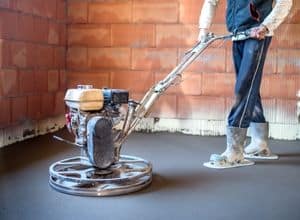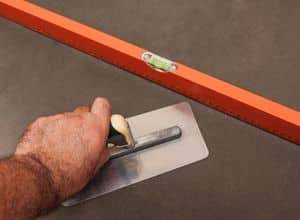Concrete floor restoration is still important because even though it’s hard and durable, concretes aren’t made of indestructible materials that can endure any force without damage. Just like any portion of a building, they, too, are at risk of degradation, so do not be surprised to see your concrete surface damaged after continuous exposure to extreme environmental factors.
When the concrete surfaces of your home or business get damaged, the best course of action is to contact a concrete floor restoration service to help you return it to its former glory.
Concrete floor restoration is simply the procedure of repairing old and damaged concrete. Restoring concrete allows it to return to its original look, and this process could be used on driveways and sidewalks as well. However, there’s a difference between concrete repair and concrete restoration. While repairing damaged concrete might fix any structural issues with the concrete, it doesn’t pay close attention to aesthetics. With concrete floor restoration, you’re getting both benefits.

One of the biggest advantages of concrete floor restoration is that it’s less expensive than new construction. Despite this, concrete restoration still gives you the appearance of having brand-new concrete on your building. Along with improving the overall look, it repairs the cracks that were structural problems.
Due to the cheaper cost, it’s easier for businesses to stay on top of concrete repairs when they choose to do concrete floor restoration. This prevents problems from getting out of hand and puts their customers and employees at risk.
Concrete floor restoration has many benefits, and below are some of them:
A concrete surface that is in good condition is most resistant to damage, and continuous exposure to the factors causing these damages can eventually result in a crack. A small crack in your concrete can turn into a gaping hole if care is not taken. Water, cold weather, and extreme weights are some of the factors that can contribute to further damage to your concrete surface. Fixing your damaged concrete floor immediately can prevent this damage from spreading.
Damaged or aging concrete can be hazardous for pedestrians and vehicles in applications like public walkways, patios, driveways, and parking garages. It’s especially dangerous when supports or foundations for buildings and structures start deteriorating.
Through concrete floor restoration, you’re creating a safer environment and minimizing the risk of:
Slipping: Worn concrete loses its natural traction, which can create slick surfaces for cars and people. Concrete floor restoration can help revitalize your concrete’s slip-resistance before things like standing water, snow, and ice worsen the problem.
Tripping: Popouts, potholes, cracks, raised edges, holes, and chips create an uneven surface that can cause people to trip. In extreme cases, it can even cause vehicular damage. It also renders the area impassable for wheelchairs, walkers, strollers, and other mobility devices that create an equal environment for your family or employees.
Instability: Unstable concrete can buckle or become uneven, usually a result of weight overload. This could have devastating results for structural concrete, causing expensive and harmful damage and creating an unsafe environment. Weakened concrete is also more susceptible to impact or erosion.
No matter how small the damage on a concrete surface is, that surface has been altered in appearance, and it may not be pleasant to the eyes. In a business setting, appearance is one of the things that customers look out for, and a visible crack on the concrete floor may not be a great image for such a business. People tend to be more comfortable in buildings that are in pristine condition compared to the ones that are not. Although this can be considered superficial, it goes a long way to affect the business’s success.
Concrete surfaces serve many purposes, one of which is to support weights. However, in the case of damage, there will be a reduction in its functionality. This also tends to affect the functionality of other parts of the building and can be a more serious problem with time.

Concrete walls, expansion joints, and concrete flooring possess natural thermal resistance that increases your facility’s R-value. Concrete traps heat, so it helps prevent heat loss in buildings. It can also reduce excess indoor moisture that may seep through, creating a more comfortable environment. Low-density concrete tends to have a higher R-value than high-density.
These insulating properties are compromised when concrete begins to deteriorate. Once trapped, moisture and air can enter the building, increasing energy costs and decreasing efficiency. The problem will worsen if left unrestored until it becomes impossible to ignore.
Concrete floor restoration can improve insulation and avoid these complications by ensuring each surface and joint is structurally sound. Regular preventive inspections can help keep them that way.
Another benefit of concrete floor restoration is correcting the underlying cause of that damage. While the most common causes of damage to concrete surfaces are fire and bad weather, there are other causes, such as aggregate expansion and exposure to certain chemicals. If the underlying cause of your concrete damage still exists, then there is still a chance of it getting damaged over and over again. It is advisable to hire a well-trained and experienced contractor for this purpose.
Quality concrete provides a stable, durable, and supportive surface or enclosure, but many outside factors can cause premature aging and degradation.
Common causes of concrete structural damage and chemical disintegration include:
Though concrete can withstand high temperatures, extreme hot and cold or constant fluctuating between extreme temperatures wears it down, especially when moisture is involved. As water pools on worn concrete, it can settle in cracks and holes. If the water freezes, it expands up to 9%, which can severely weaken the concrete.
Overloading caused by excessive weight leads to buckling, warping, cracking, and chipping. It’s a significant concern for concrete in structural joints, foundations, and high-traffic areas, like parking garages and pedestrian walkways.
Natural aging — including fading and general signs of wear — comes from frequent use and exposure. Corrosion happens from repeated elemental exposure, like hydraulic wear, or when embedded materials, like metal, begin to corrode and cause the surrounding concrete to deteriorate with it.
Accidental and unnatural damage can degrade concrete quickly — and unexpectedly. Examples include blasting, fires, and impact caused by vehicles, machinery, or tools. Impact extent can range from minor to severe, and lingering after-effects, like open cracks, make the remaining cement vulnerable to more damage if left unrestored.
Earthquakes, seismic tremors, saltwater, and tornadoes are unpreventable, and even the strongest concrete surfaces and buildings are at risk. These environmental conditions can make concrete become unlevel or cause extreme cracking and shifting that worsens.
De-icing salts, chemical sulfates, industrial waste, food and beverages, and acids create chemical reactions when exposed to concrete surfaces. This reaction can cause instability and cosmetic wear, and it weakens the concrete after significant exposure.
Prompt concrete floor restoration saves time, money, and frustration — but how do you know when it’s time to schedule an appointment? Inspect your concrete structure or surface for the following signs:
Cracks range from thin hairline markings to large crevices along walls and flooring. Factors like shrinkage and settling cause several types of cracks, and they range in severity. Even minor cracks can create an uneven walking surface or reduce your facility’s energy efficiency. Cracks may give insects and moisture a way into your building as well.

Discoloration includes stains, faded areas, minor surface corrosion and tire markings that don’t pose a structural threat but diminish your concrete’s appearance. Though not as time-sensitive as other types of damage, it doesn’t look as professional as clean, finished concrete.
Flaking is a type of slow chipping that creates a layer of fine, dust-like concrete on top of affected surfaces. This dust is messy and extremely hazardous to inhale when it produces crystalline silica.
Spalling is when the concrete’s surface starts breaking off into small or large pieces. It often happens in high-traffic areas, where it creates bumps and uneven surfaces.
Surfaces are usually uneven for one of two reasons — improper installation or concrete deterioration. Either way, uneven and sunken surfaces cause water to pool, creating an unsafe environment when it freezes. This freezing can also initiate the freeze-thaw cycle, which hastens the erosion process. Unlevel concrete surfaces do not offer long-lasting support and may cause extensive damage in structural applications.
Gaps occur between concrete joints and at the edge of sidewalks and patios. Many factors contribute to gapping, including soil erosion or movement, seismic tremors, and impact-related damage.
If your facility’s energy costs are higher than usual, and you’re unsure why it might be time to inspect your concrete surfaces and supports. Compromised insulation will reflect on your utility bill and could create environmental changes, like hot and cold patches throughout the room.
Never ignore seemingly minor signs of concrete damage. These issues threaten the integrity of your property and may pose a serious threat to employees and pedestrians. They can also worsen quickly, creating more lasting, challenging defacement.
If you notice that your concrete has one or multiple signs that indicate it is in need of repair, be sure to contact a repair and concrete floor restoration service to handle the job. Compared to other concrete contractors in Texas, we at Floor Doctor have the knowledge, experience, and equipment to offer residential and commercial concrete floor restoration to bring back your concrete’s former glory.
